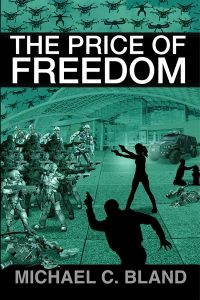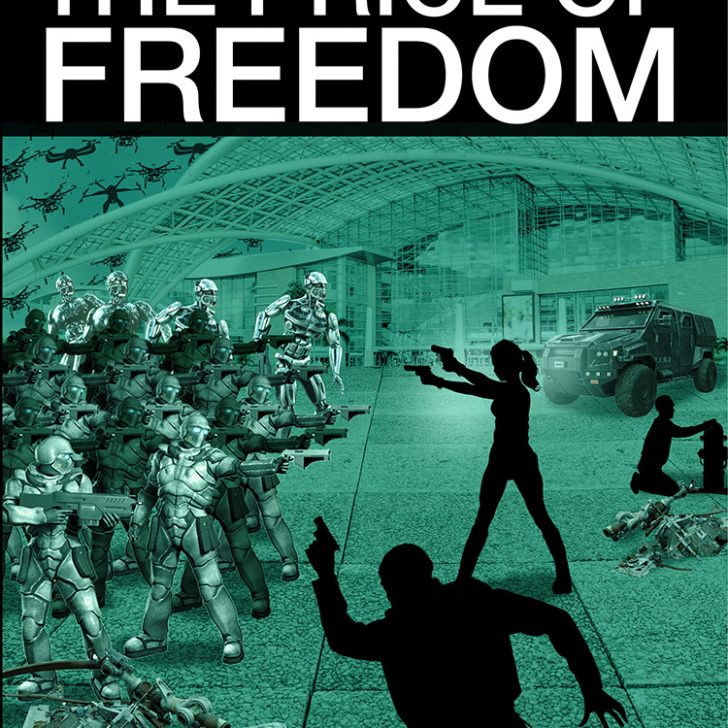The Price of Freedom by Michael Bland

It’s 2047. The rebellion has been crushed. The Agency is reestablishing control.
Rebel leader Dray Quintero languishes in his cell, struggling against his captors’ manipulations. His daughter Raven’s cries torment him at night. He has doomed them both.
When given an unexpected chance to escape prison, they break out–but they’re not safe. No one is. The Agency is still in power. And they’re tightening their grip. As dangers mount, Dray is haunted by an impossible flee and survive, or gamble his last chance for freedom by taking a stand against impossible odds.
He tried running. He tried fighting. This time, he must try something radically different. Something no one will see coming.
The Price of Freedom is the adrenaline-fueled final installment in The Price Of trilogy from multiple-award–winning author Michael C Bland.
The Price of Freedom Review
I was compensated with a small amount for my time and effort in reading the book and writing this review. However, all thoughts and opinions expressed are my own and are based on my honest personal experience reading the book. Nor did the publisher in any way shape or form ever pressure me to give a positive review.
In The Price of Freedom is adrenaline-fueled sequel to The Price of Rebellion, which I happened to have written another review for all the way back in 2023. I was delighted when the author reached out to me again because that means I was finally able to continue on from the cliff-hanger left behind in the last installment. However I couldn’t help but notice how visually similar the two covers are, and when looking back and forth between the two of them to refresh my memory, I found myself getting them mixed up a few times. However, that’s more of my own little experience when reading the book this time, let’s get to the meat of the actual review.
Dray Quintero, our protagonist and once a pioneering engineer responsible for a revolutionary nationwide surveillance network, has become the most wanted man in America. The government he once served has twisted his innovations into oppressive tools, using them to tighten its stranglehold over the populace. The Price of Freedom resumes with Dray trapped in the depths of despair within the confines of a high-security prison, haunted by the manipulated cries of his daughter Raven echoing through the night, a cruel reminder from his captors of his perceived failures and the family torn apart by his actions.
The story really picks up with Dray finally breaking free from his cell and the psychological torture from the Agency (largely thanks to his daughter Talia’s presence). With both the support of Talia and Raven, we see Dray succeed in his attempts this time compared to the last.
What I really appreciate about this book is how it continues the deep dive into years of technological advancements and political manipulations that shaped the society I loved in book one, and that carried through into book two. It’s a world where implanted neural tech doesn’t just enhance human capabilities but outright controls people’s thoughts. What was once hailed as a breakthrough for human advancement has become the ultimate tool of oppression, blinding citizens to the truth and binding them to the will of a corrupt government. That theme of technology turning “evil” due to misuse by malicious people and organizations is something I really loved seeing.
Another thing I really liked was how Dray refused to let his failures from book one hold him down. Branded a traitor and relentlessly hunted, he could have let guilt consume him, but instead, he came back stronger. His journey isn’t just about redemption, it’s more about refusing to stay broken.
I loved seeing how he reclaimed his sense of purpose, determined to fight back, expose the truth, and take back what was stolen from him. He’s not the same man who once buried those secrets, he’s someone who’s learned, adapted, and refuses to be controlled. Obviously he couldn’t have done it without the mental support from his daughters, but it’s an impressive feat nevertheless and his own mental resilience was also just as important.
Similar to The Price of Rebellion, family dynamics remains an important theme. Dray’s relationship with his daughters, particularly the revelation that Talia is alive and being used by The Agency for mind-control experiments, adds a deeply personal layer to the story. This discovery shifts Dray’s motivations from merely surviving to actively dismantling the oppressive system that has taken so much from him. The father-daughter relationship evolves dramatically, paralleling the broader theme of rebellion and liberation that courses through the trilogy.
We finally see Dray, with the help of his daughters and a newly strengthened rebel alliance, pull off a bold plan to expose the puppet Congress as nothing more than fake representatives controlled by The Agency to keep up the illusion of democracy. That moment when he finally reveals the truth to the public is such a powerful turning point. It really drove home the idea I mentioned earlier that technology isn’t inherently good or bad, it all depends on who’s controlling it. The way the story tackled both the power of truth and the dangers of deception made this payoff feel so earned.
The Price of Freedom ends on a note of cautious optimism, which honestly felt like a much brighter ending than The Price of Rebellion. With the puppet Congress exposed and The Agency losing its grip, real government leaders start stepping back in, and I liked how Dray doesn’t just walk away. He’s ready to help rebuild something better. It’s not some perfect, wrapped-up-in-a-bow ending, but that made it feel more real. The fight for freedom came at a cost, but seeing Dray and the others push forward anyway was such a strong way to close things out.
If you liked this review and want to see other book reviews like this one, check out my book reviews collection!


Leave a Reply